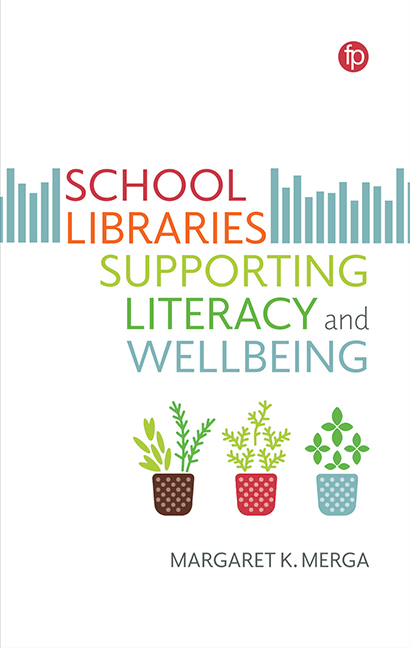Book contents
- Frontmatter
- Contents
- List of Tables
- Acknowledgements
- Abbreviations
- Introduction
- 1 What Do School Library Professionals Contribute to Student Learning and Support? A Focus on Australia and the UK
- 2 School Libraries and Reading Engagement for Literacy
- 3 Librarians Supporting Struggling Literacy Learners Beyond the Early Years
- 4 School Libraries and Reading Engagement for Student Wellbeing
- 5 School Libraries, Health Resourcing and Information Literacy
- 6 Librarians Creating Environments for Reading and Wellbeing
- 7 Challenges to Visibility and Advocacy for School Libraries and Staff
- Conclusions and Directions for Future Research
- Appendix 1 Background and Methods of My Research Projects
- Appendix 2 A Place to Get Away from It All: Five Ways School Libraries Support Student Wellbeing
- Index
6 - Librarians Creating Environments for Reading and Wellbeing
Published online by Cambridge University Press: 21 April 2022
- Frontmatter
- Contents
- List of Tables
- Acknowledgements
- Abbreviations
- Introduction
- 1 What Do School Library Professionals Contribute to Student Learning and Support? A Focus on Australia and the UK
- 2 School Libraries and Reading Engagement for Literacy
- 3 Librarians Supporting Struggling Literacy Learners Beyond the Early Years
- 4 School Libraries and Reading Engagement for Student Wellbeing
- 5 School Libraries, Health Resourcing and Information Literacy
- 6 Librarians Creating Environments for Reading and Wellbeing
- 7 Challenges to Visibility and Advocacy for School Libraries and Staff
- Conclusions and Directions for Future Research
- Appendix 1 Background and Methods of My Research Projects
- Appendix 2 A Place to Get Away from It All: Five Ways School Libraries Support Student Wellbeing
- Index
Summary
When our children and students head off to school in the morning, we want them to have safe and supportive experiences during their day that allow them to develop their academic and social skills. A key factor that may impact on their wellbeing within schools is the social climate of the school. Lenzi et al. (2017) define this broadly as ‘the physical and social features of the school context’, ‘represented by the aggregation of students’, teachers’, and other staff members’ perceptions and behaviors’ (p. 527). School libraries can make a positive contribution to the school climate, and they are also subclimates themselves, as inviting spaces that are intentionally constructed, often on meagre budgets, to foster a sense of belonging in students.
While school libraries are adaptive spaces used for many purposes (BMG Research, 2019), school library professionals may purposefully create environments that support reading for pleasure (RfP) and related student wellbeing. As I have explored in detail in the earlier chapters of this book, research suggests that RfP can be related to student wellbeing (Levine et al., 2020) and that regular reading of fiction can support development of empathy and prosocial characteristics (e.g. Mar et al., 2009). Books and reading can be used to provide respite from challenges in readers’ lives (Merga, 2017a). For more on the relationship between RfP and student wellbeing, please refer to Chapter 4 of this book, as the focus of this chapter will be specific to the role of library environments and spaces and how they contribute to student wellbeing.
Given the challenges we face in our everyday lives, both children and adults alike may crave safe spaces where they can relax, let down their guards, and be themselves. Safe spaces are environments where students feel comfortable and secure (Butler et al., 2017), and research suggests that school libraries can be learning environments that are also supportive of student wellbeing (Willis et al., 2019). Recent research with children from low socioeconomic contexts found that the most commonly selected reason for visiting the school library was because it was a ‘friendly space’ (Wood et al., 2020, p. 14), and ‘this impression was reinforced by the open-ended responses’, where ‘the most-frequently mentioned reasons for using the school library were: school curriculum, quiet place, safe haven, book access, equipment access, and selfimprovement’ (p. 13).
- Type
- Chapter
- Information
- School Libraries Supporting Literacy and Wellbeing , pp. 117 - 134Publisher: FacetPrint publication year: 2022



